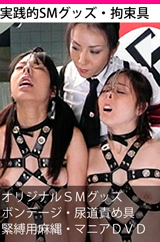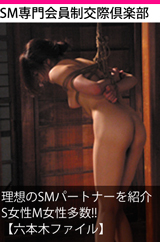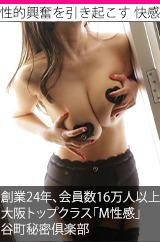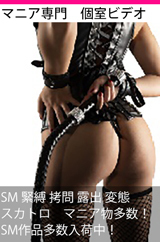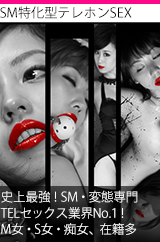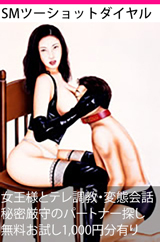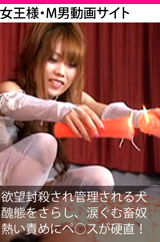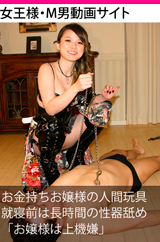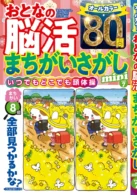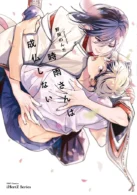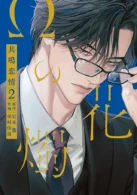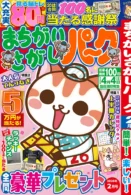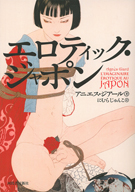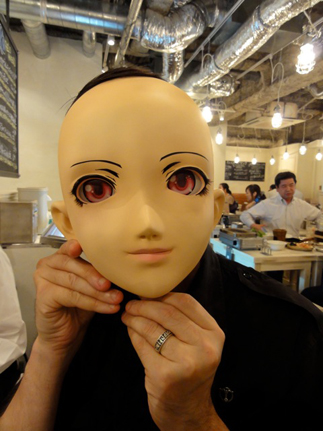
↑親友にして着ぐるみアーティスト、犬病ぬこ氏が作ったマスク。
Erotical Parade Japan
フランス人ジャーナリストのエロティック比較文化論
気鋭の女性フランス人カウンターカルチャー専門ジャーナリスト、アニエス・ジアールが、「奇妙で豊穣な性文化」について日本の様々な文化的側面から掘り下げていくユニークな比較文化論。今回のテーマは日本人のロリータコンプレックス。日本文化の歴史を振り返りながら、我が国に独特な「美」の捉え方に焦点を当てていきます。なによりもまずロリコンと、幼形成熟的美意識の二つの現象を分けて考えるべきだろう。
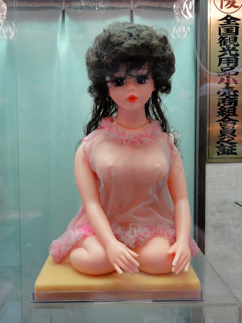
↑80年代のダッチワイフ(大阪・お初天神通りのアダルトショップにて)。
ロリコンとは最近の傾向である。これは戦後の米国支配の時代にまでさかのぼる。新しい法や経済変化の影響で、女性はどんどん強くなった。女性が自由を得たあらゆる文化において、突然にSM文学や強姦妄想は高くなる。女性が自由になればなるほど、男性は脅威を感じ、それを性やボンデージ、幼児ポルノ、血だらけでエロいシナリオの変態作品で昇華しようとするのだ。第二次大戦の前は、女性の理想像は30歳くらいで、谷ナオミのような容姿の女性だった。しかし第二次大戦後、ロリータが漫画とアニメを制した。しかしこれらのロリータは元のモデルとは全く違うものだ。ナボコフが1955年に書いた『ロリ―タ』で、彼はファムファタルの性衝動と頭をもった13歳の少女を描いた。ナボコフにとってロリータは、非常に強い精神の持ち主で、男を思い通りに操縦するロラ・ロラという娼婦に近い。だから日本のロリコン同人誌は、概してロリータ神話とは関係がない。エロ漫画の幼い犠牲者たちは、しょっちゅう誘拐されるし、襲われるし、服従させられ、レイプされる。それで男性は優位を感じるのだ。これが怖れから解放させられる浄化作用なのだ。マンチェスター大学の研究者シャロン・キンゼラは、ロリコン作品の人気を"社会における若い女性の地位と力の向上に対する敏感な気づきと、それらの若い女性が武器をとりあげられ、子供扱いされ、服従されるよう望む反動的な欲望を反映している"という(http://www.kinsellaresearch.com/) 。
しかし、たとえロリコンが最近の傾向だといっても、日本の芸術はつねに幼形成熟的美意識のもとにあったといえるのではないだろうか。平安時代には清少納言が"綺麗なもの"として"小鳥、稚児、人形の道具、小さなハスの葉、小さなものはすべて素敵だ。2歳の赤ん坊、ひよこ、白くてかわいい。雁のひな"とあげている。『枕草子』で清少納言は466回もおかし(素敵、可愛い、魅力的)という言葉を使っている。平安時代の終わりには、女性たちは自分たちを表現するために特別な言葉、赤ちゃんのような言葉を使い始めていたようである。彼女たちはおそらく"繊細でいとけない子供"と見られたかったのだろう。なぜなら当時は争いが絶えない時代で、武士がどんどん重要になってくる時代だったからである。強い武士や兵隊が現われれば現われるほど、女性は自分自身を守らなければならない。彼女たちはみずから兵士のようにふるまうか、あるいは可愛そうな、困り果てた姫のようにふるまわなければならなかった。しかし何世紀もの間、日本の美術が幼形成熟的美意識の影響を受けたのには、きっともっとたくさんの理由があるのだろう。
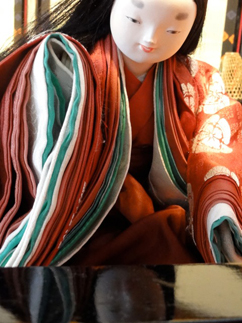
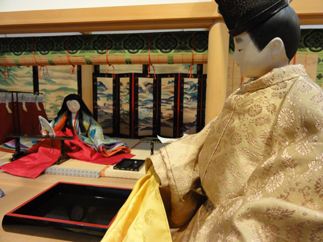
↑京都「Costume Museum 風俗博物館」で観る源氏物語の世界。
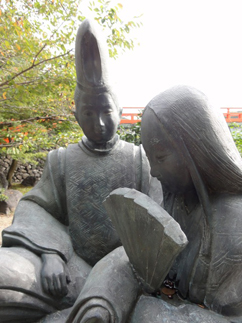
↑源氏物語像(宇治にて)。
私の最初の解釈は日本の美は常に死と関係があるということだ。美しいものは消えうせるものだ。美しい女性は花のようであらねばならない。短命であらねばならない。容色は変わり、季節の変容とともにその存在はおびやかされる。西洋では美とは彫像のようなもので、女は石でできた建造物である。日本では自然は常に変化する。だからこそ女性は萌えなのだ。私の著作『Erotic fantasy in Japan』に、この概念に関する美しい表現がある。『六ツ星きらり』を書いた美少女ゲーム作家の田中天が教えてくれたものだ。「日本人は変身を好む。完成したものや、できあがったものにはあまり感心しない。長きにわたって、我々には奇形したものにリアリティを覚える伝統がある。いまだ成長しきっていない変化の過程にあるものこそが、我々にとっては美しい。日本では美は儚い。また萌えという非常に古い概念をもっている。萌えとは育ち、発芽し、変化するものを愛することだ。我々が"萌え"というとき想像するのは、小さな植物に芽吹いたつぼみのことである」
私の二つ目の解釈は、日本の美は感情に関係するということである。西洋社会では、美は数学である。古代より、西洋人は美を合理的な視点でとらえてきた。完璧なプロポーションをした身体は、パルテノン神殿で使われた黄金比で考えられる。
レオナルド・ダビンチが美(divine proportion)を表現しようとしたとき、彼はまず正方形を描き、円を描き、身体はこの幾何学図形におさまらなければならなかった。日本では美は感情であり、頭で考えるものではない。死よりも心動かされるものがないからこそ、死は美につながっている。また赤ん坊に惹かれるのは、赤ん坊ほど助けを必要とするものはないからだろう。だから、かわいそうな動物のように目を見開き「助けて、お願い」と言う女性に惹かれるのだ。また、深い傷、または隠れた痛みに苦しむ者に共感しやすい。それが好きという言葉だ。漢字では女に子と書く。「好きです」と言う時、それは「私の子供になってください」ということだ。清少納言は『枕草子』でうまく書いている。「なにもなにも、小さきものはみなうつくし」、小さいものはみな、愛情と混じった保護欲をかきたてる(角川第146段[新潮144段、岩波151段]、うつくしきもの)。日本語では保護に関連した美意識や愛の言葉がたくさんある。たとえば普通"美しい"と訳される"うつくしい"は、全く違うものを意味していた。それは消え入りそうなものが少し心配になってしまう感情を意味する。
日本のネオテニーに関してはもっとたくさんの解釈があるだろう。でもこの二つが私が見つけた解釈だ。もっと他の発見ができるよう、助けてほしい。
文=アニエス・ジアール
翻訳=前田マナ
翻訳=前田マナ
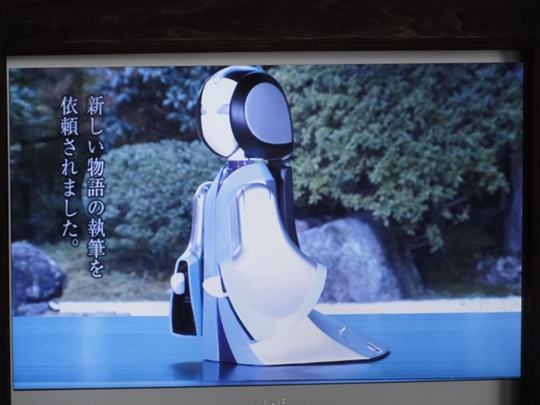
↑紫式部の可愛いロボット(嵐山にて)。
Lolita complex and neoteny: why Japanese like baby-face ?
In western countries, we paint our lips bigger, in order to have wide smiles that attract men: "I want to suck you" (here, you can add the growl of a panther…). The bigger the mouth, the bigger the sexual appetite. In Japan, the mouth must be tiny, because it means the vagina is like a shijimi (little clam with tightly closed shell), a tight virgin sex. In Japan, to make mouth look smaller, lips are usually adorned with petal-like make-up, in order to create a strange visual effect: the face of women must look like the face of a doll, with very small mouth, small chin, small nose and wide eyes. This is called "baby-face" or "neotenic face". The upper part of a baby face is always bigger than the lower part. Neoteny is an adult person with anatomic characteristics of a small child. And now, here is the question. Why do Japanese like baby face?
First of all, we have to distinguish 2 phenomenons: lolicon (gairaigo term for "Lolita complex") and neotenism aesthetic.
Lolicon is a recent trend. It dates back from the US occupation: women got more and more power under the influence of the new laws and economical changes… In all the cultures where women get more freedom, we can see a sudden rise of SM literature and rape fantasies. The more women become independent, the more men get frightened and try to compensate through sexuality, bondage, child pornography or hentai artwork full of bloody and erotic scenarios. Before WWII, the ideal woman was around 30 years old and looked like Naomi Tani. After WWII, lolita invaded manga and anime. And these lolitas were quite different from the original model: when Nabokov wrote his book Lolita in 1955, he was talking about a 13 years-old girl with the brain and libido of an adult "femme fatale". Lolita, for Nabokov, was a very strong-minded girl, very close to the prostitute named Lola Lola… A manipulative woman. In Japan, lolicon-dojinshi has most of the time nothing to do with Lolita's myth: the underage victims from erotic manga are very often kidnapped, assaulted, subdued and raped. It's a way for men to feel more powerful. It's a cathartic way to liberate from fear. Sharon Kinsella, researcher from Manchester University, argues that the popularity of lolicon artwork "reflects simultaneously an awareness of the increasing power and centrality of young women in society, and also a reactive desire to see these young women disarmed, infantilized, and subordinated." (http://www.kinsellaresearch.com/)
But it seems that - even if lolicon is a recent trend - Japanese art has always been under the influence of neotenic aesthetic. In Heian jidai, when Sei Shonagon makes lists of what is "nice" she says: "A little bird. A Chigo. The instruments used for dolls. A very small lotus leaf. Everything little is so charming. A 2 years-old baby. The chicken babies, so white and so pretty. The goose's babies". In Makura no Soshi Sei Shonagon uses the word okashi ("nice", "pretty", "charming") 466 times. It seems that at the end of Heian jidai, women started using specific words, baby-like words, to express themselves. They probably wanted to look like "delicious small children", because it was a time of fights and the warriors were getting more and more important. The more powerful warriors or soldiers are in a society, the more women have to protect themselves… They must behave either like warriors themselves, either like poor distressed damsels. But there are probably many other reasons why Japanese art stayed for so many centuries under the influence of the neotenic aesthetic.
My first explanation is that Beauty in Japan is always related to death. What is beautiful is what must disappear. A beautiful woman must be close to a flower. She has to die fast. Her colours will change. Her existence will be threatened by the change of season… In western countries, beauty is more like a statue. Woman is a stone monument. In Japan, nature is constant changing. So woman must be moe. There is a beautiful explanation of that concept in my book "Erotic fantasy in Japan". It was given to me by Takashi Tanaka, an ero-game scenario writer, who worked on Mutsu Boshi Kirari: " In Japan, we are interested in metamorphosis. The achieved things, the finished things are not interesting for us… From a long time, we have a tradition of deformed reality. Things that still did not reached their full development go through a state of transition, that is beauty for us. In Japan, beauty is hakanai (ephemeral, fragile). Also, we have a very old concept named moe. Moe means: to love something that is growing, germinating, changing… When we say "Moe!", we think about a little plant with buds on it."
My second explanation is that Beauty in Japan is related to emotion. In western country, beauty is mathematic. From antic times, we consider beauty with very rational eyes: the perfectly proportioned body is a matter of Golden Ratio, supposedly used in the Parthenon.
When the artist Leonard de Vinci wants to represent beauty ("divine proportion"), he draws first a square, then a circle and the body must fit inside these geometrical figures. In Japan, beauty is a matter of feeling, not brain. And what is more moving than something about to die? You feel more attracted towards babies, because they look so helpless. You feel more attracted to a woman, if she opens her wide eyes like a poor little animal… "Save me, please". Also, you feel more intimate with someone who suffers from a deep and hidden pain. You want to help, to protect, to take care. This is what the word suki is about : it's written with kanji for "woman" (onna) and kanji for "children" (kodomo). When you say suki desu, you mean "Be my baby". Sei Shonagon expresses that very well in Makura no Soshi : "Nanimo nanimo chiisaki mono wa mina utsukushii…". "Everything small creates a desire to protect, mixed with affection" ("charming things", note n°146). There are many esthetic or love words related to protection in Japanese. Utsukushii, for example, which is usually translated as "beautiful", means something quite different: it means that you feel a little anxious for something that could disappear.
Maybe there are many other explanations about neoteny in Japan. But these 2 are the ones I found. Help me find the others.
text=AGNES GIARD
アニエス・ジアール最新刊『エロティック・ジャポン』(河出書房新社)発売!!
『エロティック・ジャポン』
著者: アニエス・ジアール
翻訳: にむらじゅんこ
発売: 2010年12月22日
定価: 3,990円(本体3,800円)
ISBN: 978-4-309-24534-8
出版社:河出書房新社
内容:あまりに奇妙で、あまりに豊饒な日本のエロス的イメージ! 気鋭のフランス人女性ジャーナリストが論じる大胆な日本のエロティック・カルチャー……ロリコン、人形、制服フェチ、コスプレ、メイドカフェ、援助交際、風俗産業……現代アートや浮世絵、風俗雑誌など、約300点にのぼる豊富な図版を収録!
著者: アニエス・ジアール
翻訳: にむらじゅんこ
発売: 2010年12月22日
定価: 3,990円(本体3,800円)
ISBN: 978-4-309-24534-8
出版社:河出書房新社
内容:あまりに奇妙で、あまりに豊饒な日本のエロス的イメージ! 気鋭のフランス人女性ジャーナリストが論じる大胆な日本のエロティック・カルチャー……ロリコン、人形、制服フェチ、コスプレ、メイドカフェ、援助交際、風俗産業……現代アートや浮世絵、風俗雑誌など、約300点にのぼる豊富な図版を収録!
関連記事
欧米フェティッシュ・ジャーナル Fetish Journal
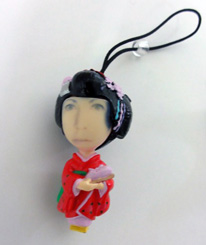
アニエス・ジアール - AGNES GIARD - 1969年生まれ。仏リベラシオン紙のジャーナリストであり、主にカウンターカルチャーや性に関する記事の専門家。日本のエロティシズムについて言及した著作 『エロティック・ジャポン』(仮)、『図解 ビザール・セックス全書』(仮)がそれぞれ河出書房新社と作品社より近日刊行予定。現在は京都の関西日仏交流会館ヴィラ九条山に滞在しており、日本における様々な恋愛物語についての本を準備中。

前田マナ 英国ランカスター大学演劇学部修士修了。専門は現代演劇やコンテンポラリーダンス。
ライターとしてウェブや雑誌等に雑文なども寄稿。
11.05.19更新 |
WEBスナイパー
>
エロティカルパレード・ジャポン!!
| |
| |


